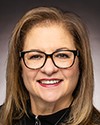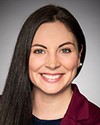I'm happy to do that.
First of all, even the term “false positive” is pejorative. It's really fearmongering, because we're not telling women they have cancer when they don't. What they use the term “false positive” to mean is a false alarm, where something showed up on your mammogram and at the end of the day it's probably not going to be cancer, but it deserves another look. For women who have anything that's out of place or that needs more testing—sometimes it's just another couple of mammogram pictures—they are recalled.
That's what it should be: a recall or a false alarm. With the majority of women, we can sort it out with ultrasounds or mammograms. If you take the real numbers in this country, out of every thousand women who are screened, 70 will be recalled, and of those 70, 11 of them—so now we're talking about 11 out of the thousand—will be told that they should have a needle biopsy.
I must tell you that a needle biopsy is done with adequate local freezing, and most women say it's no more uncomfortable than a blood test from the arm. I know that no one believes me when I say that, but the best comment I ever heard from a patient was, “Dr. Gordon, I have shoes that are more uncomfortable than this test.”
In any case, out of the 11 who have a needle biopsy, four of them are told that they have cancer. For the 11 women going through this test, the task force calls them “unnecessary” tests. Well, it's not an unnecessary test until you find the answer. Most women would rather go through something relatively painless to be more sure that they don't have cancer.
That's the false alarm story.
Overdiagnosis is a little tougher to explain. Overdiagnosis is when we find a cancer and it's a real cancer, but that cancer would not have killed the patient had it been left untreated. The typical scenario is that, if we're dealing with an elderly woman and we find a small cancer, it may not be problematic for five or 10 years, but she's also got lung cancer because she's older and she's at higher risk for lung cancer. That lung cancer is going to kill her before her breast cancer would.
Here's another example. A woman gets diagnosed with cancer, she gets treated, she finishes all her treatment and two weeks later she gets hit by a car and dies. That's actually overdiagnosis, because that cancer wasn't going to kill her, but unless you have a crystal ball and you know that you're not going to have a fatal heart attack or be hit by a car, every woman with a new diagnosis of cancer is offered treatment.
It's estimating overdiagnosis that's tricky. The task force used an estimate of 48%. They said that almost half of cancers are overdiagnosed, meaning that they shouldn't have been found or treated. That's because they got that data from that flawed Canadian trial that we heard about from Dr. Narod, and that's why there was no difference in the death rate and all their stats are off. International experts believe that overdiagnosis occurs in about 1% to 10% of women, and probably at the lower end of that range. Now remember that these are real cancers. It's just a question of whether that cancer is going to kill the woman.
Most importantly, our task force is using overdiagnosis as a reason to not screen women in their forties. Women in their forties are much less likely to have a competing cause of death and overdiagnosis in that age group is negligible, so it's absolutely not a reason to not screen women. When it comes to false alarms, we should not only be telling women about overdiagnosis and false alarms but also letting them know there's a possibility that they'll be recalled and mostly it turns out to be nothing.
It's condescending for the task force to decide on behalf of women that they're too fragile to handle a little transient anxiety. Women should be able to decide for themselves. If they say, “No, it would ruin my life and I'd rather risk getting cancer”, that's a woman's choice. Most women, when they understand the principles of overdiagnosis and false alarms, would like to be screened.





